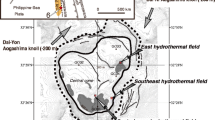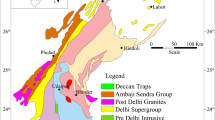Abstract
Massive sulfide precipitates found in the Southwest Indian Ridge (SWIR) 49.6°E hydrothermal field are enriched in gold. Here, the mineralogy and mineral chemistry of these massive sulfides to constrain the process of gold precipitation were studied. Sulfide samples in this field include lower-temperature Zn-rich sulfides and relative higher-temperature Fe-rich sulfides. Zn-rich sulfides are dominated by sphalerite-pyrite-chalcopyrite assemblages, with concentrations of gold ranging from 9.08 to 17.0 µg/g. Fe-rich sulfides consist mainly of pyrite-marcasite-isocubanite assemblages, with gold concentrations from 2.17 to 3.79 µg/g. The significant enrichment in gold within the lower-temperature Zn-rich sulfides and the effective separation of Zn and Fe in hydrothermal precipitates at the surface of this field are here interpreted to reflect the strong temperature dependence of gold transportation and deposition within the sulfides. In Zn-rich samples, large amounts of isolated native gold grains were identified. They were found mainly as inclusions up to 8 µm in diameter, occupying porous cavities in sphalerite or in the elevated iron content rim of sphalerite. The fineness of the gold ranged from 810 to 830. Unlike previously published results on other hydrothermal fields, these data show a low gold fineness values in SWIR 49.6°E. The FeS content of sphalerite associated with gold grains ranged from 3.2 mole % to 18.9 mole %. This was higher than in other fields, indicating that the sulfur activity is relatively low during the gold precipitation process and that sulfur activity may be one of the main factors affecting gold fineness in the SWIR 49.6°E hydrothermal field. Evidence regarding gold fineness and sulfur activity suggests that gold was quite likely transported as AuHS0 rather than as a Au(HS) −2 complex.
Similar content being viewed by others
References
Barton M D. 1980. The Ag-Au-S system. Economic Geology, 75(2): 303–316
Barton P B, Toulmin P. 1964. The electrum-tarnish method for the determination of the fugacity of sulfur in laboratory sulfide systems. Geochimica et Cosmochimica Acta, 28: 619–640
Barton P B, Toulmin P. 1966. Phase relations involving sphalerite in the Fe-Zn-S system. Economic Geology, 61(5): 815
Dick H J B, Lin J, Schouten H. 2003. An ultraslow-spreading class of ocean ridge. Nature, 426: 405–412
Fouquet Y, Wafik A, Cambon P, et al. 1993. Tectonic setting and mineralogical and geochemical zonation in the Snake Pit sulfide deposit (Mid-Atlantic Ridge at 23°N). Economic Geology, 88(8): 2018–2036
Georgen J E, Lin J, Dick H J B, et al. 2001. Evidence from gravity anomalies for interactions of the Marion and Bouvet hotspots with the Southwest Indian Ridge: Effects of transform offsets. Earth and Planetary Science Letters, 187(3–4): 283–300
Hannington M, Herzig P, Scott S D, et al. 1991. Comparative mineralogy and geochemistry of gold-bearing sulfide deposits on the mid-ocean ridges. Marine geology, 101(1–4): 217–248
Hannington M D, de Ronde C E J, Petersen S, et al. 2005. Sea-floor tectonics and submarine hydrothermal systems. In: Hedenquist J W, Thompson J F H, Goldfarb R J, et al., eds. Economic Geology, 100th Anniversary Volume, 1905–2005. Society of Economic Geologists, Littleton, Colorado, 111–141
Hannington M D, Peter J M, Scott S D, et al. 1986. Gold in sea-floor polymetallic sulfide deposits. Economic Geology, 81(8): 1867–1883
Hannington M D, Scott S D. 1989a. Gold mineralization in volcanogenic massive sulfides: implications of data from active hydrothermal vents on the modern seafloor. Economic Geology Monograph, 6: 491–507
Hannington M D, Scott S D, 1989b. Sulfidation equilibria as guides to gold mineralization in volcanogenic massive sulfides; evidence from sulfide mineralogy and the composition of sphalerite. Economic Geology, 84(7): 1978–1995
Hannington M D, Tivey M K, Larocque A C, et al. 1995. The occurrence of gold in sulfide deposits of the TAG hydrothermal field, Mid-Atlantic Ridge. Canadian Mineralogist, 33: 1285–1310
Herzig P M, Hannington M D, Fouquet Y, et al. 1993. Gold-rich polymetallic sulfides from the Lau back arc and implications for the geochemistry of gold in sea-floor hydrothermal systems of the Southwest Pacific. Economic Geology, 88(8): 2182–2209
Ihle T, Petersen S, Herzig P M, et al. 2005. Siting of gold and characteristics of gold-bearing massive sulfides from the interior of the felsic-hosted PACMANUS massive sulfide deposit, eastern Manus basin (PNG). In: Mao Y, Bierlein F P, eds. Mineral Deposit Research: Meeting the Global Challenge: Proceedings of 8th Biennial SGA Meeting, Beijing, China, 18–25 August 2005. Springer-Verlag: 623–626
Meyzen C M, Ludden J N, Humler E, et al. 2005. New insights into the origin and distribution of the DUPAL isotope anomaly in the Indian Ocean mantle from MORB of the Southwest Indian Ridge. Geochemistry Geophysics Geosystems, 6(11): Q11K11
Moss R, Scott S D. 2001. Geochemistry and mineralogy of gold-rich hydrothermal precipitates from the eastern Manus Basin, Papua New Guinea. Canadian Mineralogist, 39(4): 957–978
Mozgova N N, Trubkin N V, Borodaev Y S, et al. 2008. Mineralogy of massive sulfides from the Ashadze hydrothermal field,13°N, Mid-Atlanditc Ridge. Canadian Mineralogist, 46(3): 545–567
Muller M R, Minshull T A, White R S, et al. 2000. Crustal structure of the Southwest Indian Ridge at the Atlantis II Fracture Zone. J Geophys Res, 105: 25809–25828
Murphy P J, Meyer G. 1998. A gold-copper association in ultramafic-hosted hydrothermal sulfides from the Mid-Atlantic Ridge. Economic Geology, 93(7): 1076–1083
Münch U, Lalou C, Halbach P, et al. 2001. Relict hydrothermal events along the super-slow Southwest Indian spreading ridge near 63°56′E—Mineralogy, chemistry and chronology of sulfide samples. Chem Geol, 177: 341–349
Pal’yanova G. 2008. Physicochemical modeling of the coupled behavior of gold and silver in hydrothermal processes: Gold fineness, Au/Ag ratios and their possible implications. Chemical Geology, 255(3–4): 399–413
Patriat P, Segoufin J. 1988. Reconstruction of the Central Indian Ocean. Tectonophysics, 155(1–4): 211–234
Sauter D, Cannat M. 2010. The ultraslow spreading Southwest Indian Ridge, in diversity of hydrothermal systems on slow spreading ocean ridges. Geophys Monogr Ser, 153–173
Schmidt K, Koschinsky A, Garbe-Schnberg D, et al. 2007. Geochemistry of hydrothermal fluids from the ultramafic-hosted Logatchev hydrothermal field, 15 N on the Mid-Atlantic Ridge: temporal and spatial investigation. Chemical geology, 242(1–2): 1–21
Scott S D, Barnes H L. 1971. Sphalerite geothermometry and geobarometry. Economic Geology, 66(4): 653–669
Seward T M. 1991. The hydrothermal chemistry of gold. In: Fpster R P, ed. Gold Metallogeny and Exploration. Glasgow: Blochie and Son Ltd, 37–62
Seward T M, Barnes H L. 1997. Metal transport by hydrothermal ore fluids. Geochemistry of Hydrothermal Ore Deposits, 3: 435–486
Shimazaki Y. 1974. Ore minerals of the Kuroko-type deposits. Mining Geol Spec Issue, 6: 311–322
Tao Chunhui, Lin Jian, Guo Shiqin. 2007. Discovery of the first active hydrothermal vent field at the uhraslow spreading Southwest Indian Ridge: The Chinese DY115-19 Cruise. Ridge Crest News, 16: 25–26
Ye Jun, Shi Xuefa, Yang Yaomin, et al. 2011. Mineralogy of sulfides from ultraslow spreading Southwest Indian Ridge 49. 6°E hydrothermal field and its metallogenic significance. Acta Mineralogica Sinica, 31(1): 17–29
Author information
Authors and Affiliations
Corresponding author
Additional information
Foundation item: The International Seabed Area 11th Five Year Plan Program of China Ocean Mineral Resources R&D Association under contract No. DYXM-115-01-2-1; the International cooperation program of the Ministry of Science and Technology under contract No. 2006DFB21620; the program of the National Natural Science Foundation of China under contract No. 40776034; Grant from the scientific research fund of the First Institute of Oceanography, SOA under contract No. GY02-2012G10.
Rights and permissions
About this article
Cite this article
Ye, J., Shi, X., Yang, Y. et al. The occurrence of gold in hydrothermal sulfide at Southwest Indian Ridge 49.6°E. Acta Oceanol. Sin. 31, 72–82 (2012). https://doi.org/10.1007/s13131-012-0254-4
Received:
Accepted:
Published:
Issue Date:
DOI: https://doi.org/10.1007/s13131-012-0254-4




